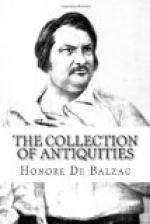“If I was playing with other children on the Parade, and she came to walk there with her nephew Victurnien, the sight of her in the distance thrilled me with very much the effect of galvanism on a dead body. Child as I was, I felt as though new life had been given me.
“Mlle. Armande had hair of tawny gold; there was a delicate fine down on her cheek, with a silver gleam upon it which I loved to catch, putting myself so that I could see the outlines of her face lit up by the daylight, and feel the fascination of those dreamy emerald eyes, which sent a flash of fire through me whenever they fell upon my face. I used to pretend to roll on the grass before her in our games, only to try to reach her little feet, and admire them on a closer view. The soft whiteness of her skin, her delicate features, the clearly cut lines of her forehead, the grace of her slender figure, took me with a sense of surprise, while as yet I did not know that her shape was graceful, nor her brows beautiful, nor the outline of her face a perfect oval. I admired as children pray at that age, without too clearly understanding why they pray. When my piercing gaze attracted her notice, when she asked me (in that musical voice of hers, with more volume in it, as it seemed to me, than all other voices), ’What are you doing little one? Why do you look at me?’—I used to come nearer and wriggle and bite my finger-nails, and redden and say, ’I do not know.’ And if she chanced to stroke my hair with her white hand, and ask me how old I was, I would run away and call from a distance, ‘Eleven!’
Every princess and fairy of my visions, as I read the Arabian Nights, looked and walked like Mlle. d’Esgrignon; and afterwards, when my drawing-master gave me heads from the antique to copy, I noticed that their hair was braided like Mlle. d’Esgrignon’s. Still later, when the foolish fancies had vanished one by one, Mlle. Armande remained vaguely in my memory as a type; that Mlle. Armande for whom men made way respectfully, following the tall brown-robed figure with their eyes along the Parade and out of sight. Her exquisitely graceful form, the rounded curves sometimes revealed by a chance gust of wind, and always visible to my eyes in spite of the ample folds of stuff, revisited my young man’s dreams. Later yet, when I came to think seriously over certain mysteries of human thought, it seemed to me that the feeling of reverence was first inspired in me by something expressed in Mlle. d’Esgrignon’s face and bearing. The wonderful calm of her face, the suppressed passion in it, the dignity of her movements, the saintly life of duties fulfilled,—all this touched and awed me. Children are more susceptible than people imagine to the subtle influences of ideas; they never make game of real dignity; they feel the charm of real graciousness, and beauty attracts them, for childhood itself is beautiful, and there are mysterious ties between things of the same nature.




